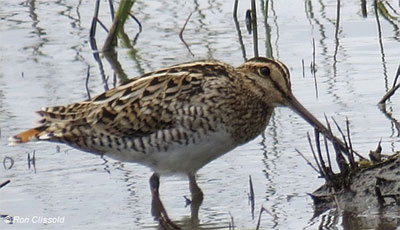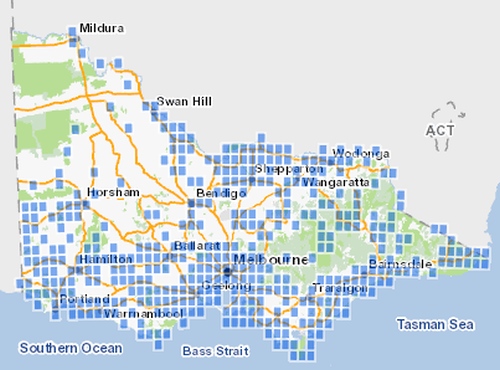Latham's Snipe
Latham's SnipeGallinago hardwickii | |
|---|---|
| Kingdom: | Animalia |
| Phylum: | Chordata |
| Class: | Aves |
| Order: | Charadriiformes |
| Family: | Scolopacidae |
| Status | |
| World: | Near Threatened (IUCN Red List 2025) |
| Australia: | Vulnerable (EPBC Act 1999) |
| Australia: | Listed Migratory species (EPBC Act 1999) |
| Australia: | Listed under JAMBA, CAMBA, ROKAMBA, Bonn Convention. |
| Victoria: | Vulnerable (FFG Threatened List 2025) |

Latham’s Snipe Gallinago hardwickii, also known as Japanese Snipe, is a medium-sized (150-200g) migratory shorebird which migrates between the northern and southern hemispheres.
Distribution in Victoria

All known historic records of Latham's Snipe in Victoria. Source: VBA 2024
Ecology & Habitat
Latham’s Snipe is a shy, secretive bird that is generally widely dispersed in low numbers across wetland and grassland areas. They differ to other shorebird species in preferring open freshwater or brackish wetlands with cover nearby, particularly areas of wet tussock grassland and other dense ground vegetation.
During the day snipe prefer to roost in grass and weeds in close proximity to water and at night they disperse to feed in nearby wet paddocks, ditches and other open flooded areas. The distance they move nightly to feed is unknown; however, shorebirds tend to roost in close proximity to their feeding habitats in order to reduce the amount of energy used in nightly transit.
The distance between snipe roosting and optimal feeding habitats is likely to be minimal in order to reduce flight times and so, conserve energy.

Migration
Latham’s Snipe breeds in Japan and south-east Siberia. Most of the population spends its non-breeding season in eastern Australia from August to February, with the largest concentrations occurring in south-eastern Australia.
 Migration of Latham's Snipe (P3) in 2018. Source: Latham's Snipe Project.
Migration of Latham's Snipe (P3) in 2018. Source: Latham's Snipe Project.
Threats
In Australia, Latham’s Snipe were hunted until the late 70s – early 80s, when hunting bans were introduced.
Latham’s snipe are declining in Japan and are also thought to be declining in Australia.
The major current threats to snipe in both Australia and Japan;
- Loss of habitat (particularly wetlands).
- Loss of swamps and paddocks for feeding, meadowlands for breeding, particularly on private land.
- Development in rural and urban areas which deplete habitat or in such proximity to render habitat unusable.
Conservation Status
Australia
In 2000, the conservation status of Latham's Snipe in Australia was considered Not threatened (Garnett & Crowley 2000). This was upgraded to near threatened in 2021 and Vulnerable in 2024 when it was also Listed under the EPBC Act 1999.
Victoria
In 2013, the conservation status of Latham's Snipe in Victoria was Near Threatened (DEPI 213). The status was upgraded to Vulnerable in 2024 and also Listed under the Victorian (FFG Threatened List 2024).
Management
Latham's Snipe Project - This project is using a combination of animal tracking technology, field observations and systematic surveys to determine habitat preferences and movement patterns of Latham’s Snipe, both in Australia, Japan and on migration. Project activity is focusing on populations in south-west Victoria, which is the species’ stronghold in Australia but has also lost over 70% of its wetlands in the last 100 years.
Belmont Common (near Geelong).
Powling Street wetlands (near Port Fairy). See Latham's Snipe project.
Winton Wetlands (near Benalla) - surveys are undertaken to determine the numbers of Latham's Snipe in the area.
Wetland restoration projects across Victoria help to increase potential habitat.
Latham’s Snipe feeding in south-west Victoria woody wetland project
Latham’s Snipe feeding in south-west Victoria woody wetland. Part of the Basalt to Bay Landcare Network Inc. project using remote camera to detect Latham’s Snipe at St Helens Reserve, near Warranambool.
Guidelines for restoring and managing wetland habitat for Latham’s Snipe
The guidelines contain information for managing and reinstating wetland habitat for Latham’s Snipe. It is intended for use by land managers such as Natural Resource Management (NRM) bodies, practitioners. The Guidelines contain:
Important habitat characteristics:
- Day time sites are usually freshwater or brackish wetlands with thick but “gappy” cover of low-moderate height vegetation (typically 20-60 cm).
- Night-time feeding sites are usually open muddy wetlands that may have some nearby fringing vegetation.
- Variable wetland depth which contains areas of shallow water (<10 cm) and muddy margins.
Key management actions:
- Legal protection of wetland habitat that currently supports snipe (EPBC Act 1999). Sites supporting 18 or more Latham’s Snipe potentially qualify as nationally important habitat under the Environment Protection and Biodiversity Conservation Act 1999, and therefore, any planned changes to land use (no matter how minor) may require referral to the Commonwealth.
- Consideration of sites in the whole-landscape context, to ensure connectivity between roosting and feeding wetlands.
- Identification of nearby night-time feeding areas (usually within 1-2 km of daytime roosts) and inclusion of a “management zone” that represents the full suite of habitat required.
- “Buffering” of snipe habitat areas through establishing and maintaining vegetative margins and, where appropriate, exclusion zones to reduce human disturbance. Buffers should ideally be a minimum of 75-110 m.
- Reduction and / or cessation of mowing in core roosting habitat areas and mowing of adjacent areas should be minimised (i.e. not excessively low in height).
- No burning within 100 m of roosting habitat at any time while snipe are present.
- No grazing of roost sites while snipe are potentially present.
- Establishment and maintenance of appropriate vegetation structure in shallow water areas and along wetland margins for provision of day time roosting habitat. This should be thick but variable cover of tussocky or hummocky grasses and other plant types, 20-60cm high, that allows for gaps.
- Promotion of night time foraging areas through retention of open, shallow (<10 cm), muddy areas. This may require control of encroaching vegetation into muddy areas, periodic watering and drawdown.
- Establishment / maintenance of “retreat” habitat like reeds, wetland shrubs and taller wetland vegetation adjacent to muddy areas. These may benefit other species like bitterns.
- Communication with stakeholders including local residents. This includes signage for education purposes as well as exclusion advice in wetlands and provision of broader information to raise awareness via newsletters, social media and field activity sessions.
Hansen B, Walters J, Akers R. (2024) Guidelines for restoring and managing wetland habitat for Latham’s Snipe. Unpublished report produced by the Latham’s Snipe Project. DOI:10.25955/28139495
References & Links
DEPI (2013) Advisory List of threatened vertebrate fauna, Department of Environment and Primary Industries, Victoria.
Department of the Environment; Latham's Snipe - Listed Migratory Species
Department of the Environment (2016). Gallinago hardwickii in Species Profile and Threats Database, Department of the Environment, Canberra.
EPBC Act (1999) Status upgraded to Vulnerable, January 2024.
FFG Threatened List (2025) FFG Threatened List 2025, Department of Energy, Environment and Climate Action (DEECA), Victoria.
Garnett, S.T. & G.M. Crowley (2000). The Action Plan for Australian Birds 2000. . Canberra, ACT: Environment Australia and Birds Australia.
IUCN (2025) BirdLife International. 2022. Gallinago hardwickii. The IUCN Red List of Threatened Species 2012: e.T22693078A38767826. Downloaded on 15 December 2025.
VBA 2024. Victorian Biodiversity Atlas, Department of Energy,Environment and Climate Action, Victoria.
See also: Latham's Snipe Project

